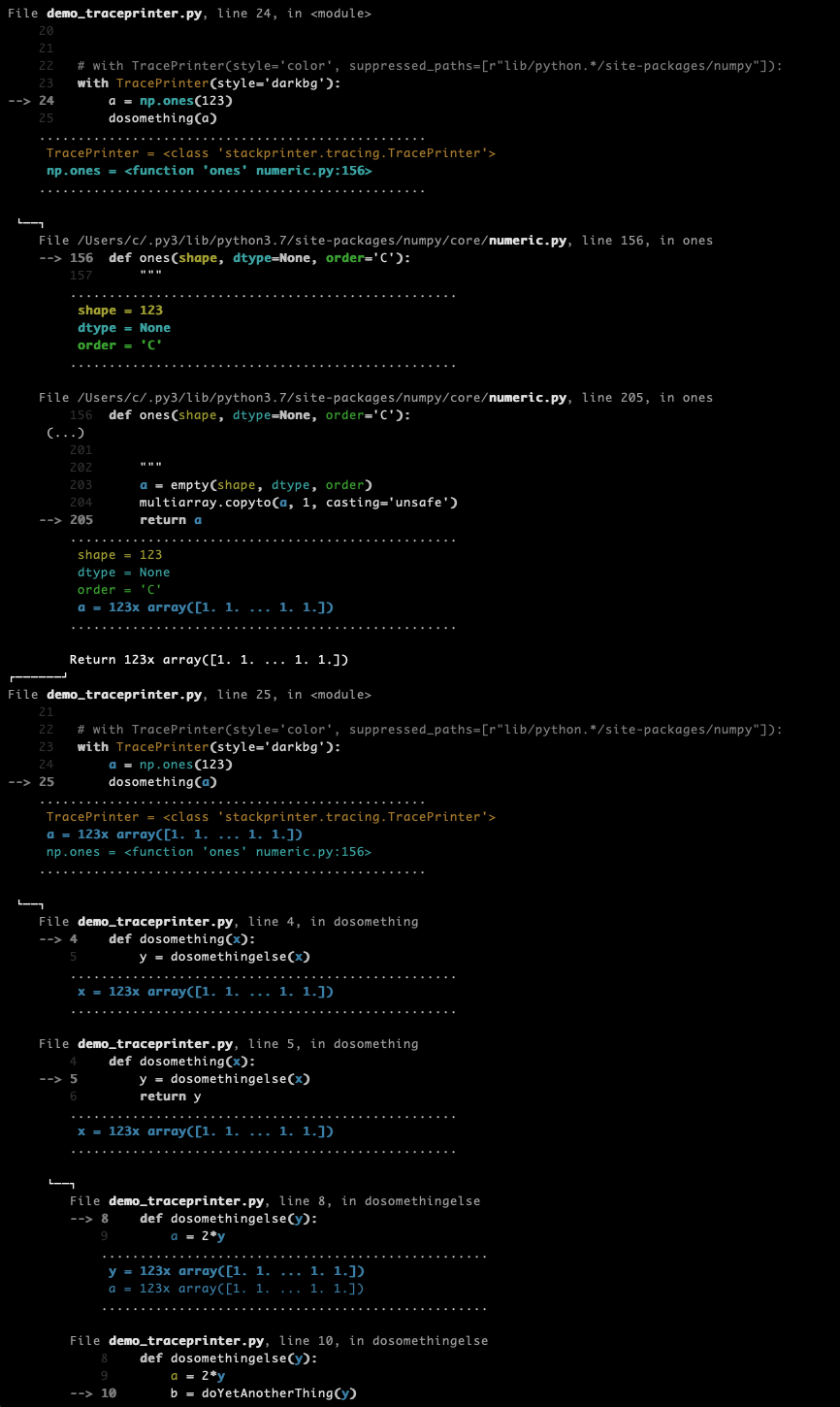Prettier tracebacks & call stacks, with variable values and colorful semantic highlighting
Project description
Python stack formatter
Print prettier tracebacks & call stacks, with more source code context and current variable values, to stay fearless when the only debugging tool is a log file.
Before

After

Installation
pip install stackprinter
Logging exceptions
To just replace the default python crash message, call set_excepthook() somewhere once:
import stackprinter
stackprinter.set_excepthook(style='color')
For manual mode, call show or format inside an except block to trace the current exception. show prints to stderr, format returns a string (for logging). You can also pass exception objects explicitly.
try:
something()
except:
stackprinter.show() # grab the current exception and print a traceback to stderr
# ...or only return a string, e.g. for logging.
message = stackprinter.format()
logging.log(message)
By default, this will generate plain text. Pass style='color' to any of these functions to get funky terminal colors (a type of semantic highlighting, not syntax highlighting). For more configs, see the docs of format().
Printing the call stack of another thread
Pass a thread object to show or format.
thread = threading.Thread(target=something)
thread.start()
while True:
stackprinter.show(thread) # or format(thread)
time.sleep(0.1)
Printing the call stack of the current thread
Call show or format outside of exception handling.
stackprinter.show() # or format()
There's also show_current_stack(), which does the same thing everywhere, even inside except blocks.
Tracing a piece of code as it is executed
More for curiosity than anything else, you can watch a piece of code execute step-by-step, printing a trace of all calls & returns 'live' as they are happening. Slows everything down though, of course.
tp = stackprinter.TracePrinter(style='color', suppressed_paths=[r"lib/python.*/site-packages/numpy"])
tp.enable()
a = np.ones(111)
dosomething(a)
tp.disable()

How it works
Basically, this is a frame formatter. For each frame on the call stack, it grabs the source code to find out which source lines reference which variables. Then it displays code and variables in the neighbourhood of the last executed line.
Since this already requires a map of where each variable occurs in the code, it was difficult to not also implement the whole semantic highlighting color thing seen in the screenshots. The colors are ANSI escape codes now, but it should be fairly straightforward™ to render the underlying data without any 1980ies terminal technology. Say, a foldable and clickable HTML page with downloadable pickled variables. For now you'll have to pipe the ANSI strings through ansi2html or something.
Caveats
This displays variable values as they are at the time of formatting. In multi-threaded programs, variables can change while we're busy walking the stack & printing them. So, if nothing seems to make sense, consider that your exception and the traceback messages are from slightly different times. Sadly, there is no responsible way to freeze all other threads as soon as we want to inspect some thread's call stack (...or is there?)
Docs
*coughs*
For now, just look at all the doc strings, e.g. of format()
Project details
Release history Release notifications | RSS feed
Download files
Download the file for your platform. If you're not sure which to choose, learn more about installing packages.
Source Distribution
Built Distribution
Hashes for stackprinter-0.1.1.post1-py3-none-any.whl
| Algorithm | Hash digest | |
|---|---|---|
| SHA256 | 3fd305ce99b48d86f883a050be3c4b71a5459ba37a842bafe20e480627c05216 |
|
| MD5 | ffa6b6ea8e496fad5d08aeb3e3a031d5 |
|
| BLAKE2b-256 | 349ae1cde52afa38b90a29fa738f80f06cbbb2bb8303e5f754d427aae8b1aea5 |











